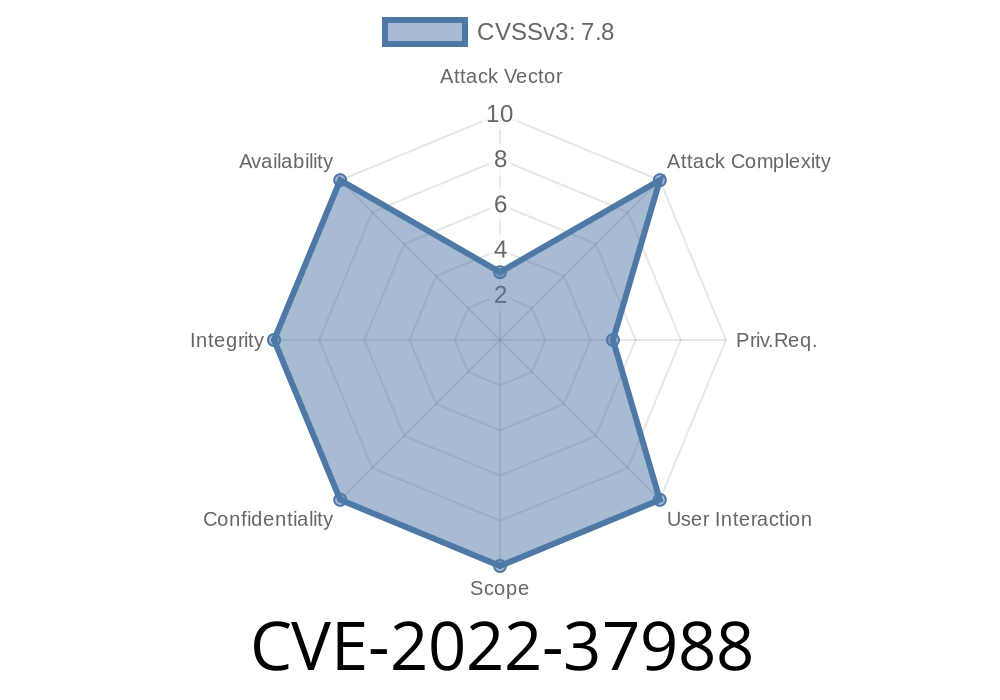CVE-2022-37988 is a Windows Kernel Elevation of Privilege vulnerability that has been discovered recently. This critical security flaw can lead to sensitive system information disclosure and unauthorized elevation of privileges, thereby posing a high risk to Windows users. The CVE ID for this vulnerability is unique and should not be confused with other associated vulnerabilities, such as CVE-2022-37990, CVE-2022-37991, CVE-2022-37995, CVE-2022-38022, CVE-2022-38037, CVE-2022-38038, and CVE-2022-38039.
In this post, we will delve into the technical details of CVE-2022-37988, providing insights into its exploitation and potential impact. We will also provide a code snippet and links to important references for a thorough understanding.
Exploit Details
The vulnerability is present in the Windows Kernel and can be exploited by an attacker running a specially crafted application that leverages the vulnerable component. Successful exploitation of this vulnerability can lead to a local attacker gaining elevated privileges, which can compromise the system's security and enable the attacker to execute malicious actions.
The primary cause of the vulnerability is the improper handling of certain objects in memory, which results in an integer overflow and consequently a buffer overflow. The following code snippet demonstrates the specific flaw in the vulnerable Windows Kernel function:
void VulnerableFunction(ULONG user_value)
{
SIZE_T size;
PVOID buffer;
// Integer overflow occurs when the user_value is added to a constant
size = user_value + CONSTANT;
// Buffer is allocated based on the calculated size
buffer = ExAllocatePool(NonPagedPool, size);
// Buffer overflow when user data is copied to buffer
RtlCopyMemory(buffer, user_data_pointer, user_value);
}
As shown in the code snippet, the integer overflow occurs when the user_value is added to a fixed constant. Consequently, the calculated size may not be accurate, leading to a buffer overflow when user data is copied to the buffer.
Original References & Mitigations
Microsoft has acknowledged this vulnerability and released security updates to address and fix the issue. To ensure the security of your system, it is highly recommended to apply the latest updates available from Microsoft.
The following links contain detailed information regarding CVE-2022-37988, including advisories, patches, and recommendations:
1. Microsoft Security Advisory - CVE-2022-37988
2. MITRE CVE Entry - CVE-2022-37988
3. NIST National Vulnerability Database - CVE-2022-37988
To mitigate potential risks associated with this vulnerability, users are advised to apply the security updates provided by Microsoft promptly. Additionally, restricting access to affected systems to only the necessary user accounts and limiting program execution rights can also reduce the likelihood of successful exploitation.
Conclusion
CVE-2022-37988 is a serious Windows Kernel Elevation of Privilege vulnerability that can put Windows users at risk. It is essential to understand the technical details, exploit mechanisms, and potential impact of this flaw to secure your system effectively. Stay informed and update your Windows environment as needed to protect against this vulnerability and prevent unauthorized elevation of privileges.
Timeline
Published on: 10/11/2022 19:15:00 UTC
Last modified on: 10/11/2022 19:16:00 UTC
